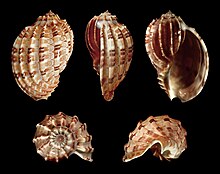Harpa
| Harpa | ||||||||||||
|---|---|---|---|---|---|---|---|---|---|---|---|---|

Harpa major , William Charles Linnaeus Martin : Pictorial Museum of Animated Nature (1848–1849), vol. 2, p. 236. |
||||||||||||
| Systematics | ||||||||||||
|
||||||||||||
| Scientific name | ||||||||||||
| Harpa | ||||||||||||
| Röding , 1798 |
Harpa is the name of agenus of snail from the family of harp snails (Harpidae), which is found in tropical waters in the Indo-Pacific and on the West African coast of the Atlantic .
features
The right-hand wound housings of the Harpa species have a large body circumference and a short thread. The short siphon channel is formed by a shallow notch on the outer lip of the mouth towards the columella. The Protoconch has 3 or 4 mostly purple, nodular whorls. The thread is formed by the 3 following turns. Characteristic of the snail shells of the Harpa genus are the varices, which are designed as longitudinal ribs, each of which ends in a short spike towards the thread. They are usually drawn with reddish and pink zones, while the longitudinal grooves between them have brownish-red spots on a flesh-colored background. The snails have no operculum.
The body of the snail has a vivid color of various red, brown and yellow shades with spots on a lighter background. The feelers and the Sipho are irregularly curled. The eyes are at the base of the antennae. The foot is very large and consists of a crescent-shaped, very wide propodium and a metapodium, which are only connected at a narrow point. In the event of a disruption, the anterior part of the metapodium can be split off by an autotomy . Continuous movement can cause the thrown off part to distract a predator. The missing piece is regenerated .
The radula is of type Stenoglossa (Rachiglossa), wherein only the middle tooth and sometimes two lateral teeth are made. It is generally very small and in some cases only occurs in young animals.
The diet of the Harpa species consists of decapods , which are covered with the propodium and wedged between this and the metapodium and then enveloped by sticky mucus. The exact eating process is not documented. Empty crab shells remain.
The snails are separate sexes. The male mates with the female with his penis . The female lays egg clutches with 10 to 15 egg capsules, each containing 3000 to 4000 eggs. The hatching Veliger larvae go through a phase as plankton until they metamorphose into the finished young snail .
History of the system
Harpa means a harp in Latin . In 1758 Linnaeus describes two species of the genus Buccinum ( B. harpa and B. costatum ) as a snail with similar, clearly separated (in B. costatum densely packed) and pointed longitudinal ribs that live in front of Bengal. The generic name is Harpa , in German the harp, with 7 types by Peter Friedrich Röding in 1798 in the catalog of the Conchyliensammlung by Joachim Friedrich Bolten .
literature
- Frank Riedel: Origin and evolution of the "higher" Caenogastropoda . Berliner Geoscientific Abhandlungen, Series E, Volume 32, Berlin 2000, 240 pages, ISBN 3-89582-077-6 .
- J. Berkhout (1992): The genus Harpa Röding, 1798 (Het geslacht Harpa Röding, 1798) (Mollusca: Gastropoda: Harpidae) (PDF file; 2.24 MB) . Vita Marina 41 (4): 115.
Individual evidence
- ↑ Langenscheidt's Latin-German dictionary: entry Harpa, (Germanic loan word) (late Latin) harp. 7th edition 1982.
- ↑ Carolus Linnaeus : Systema Naturae. 10th ed., Lars Salvius: Stockholm 1758, p. 734: No. 288. Buccinum , p. 738: Buccinum Harpa. 400. B. testa costis aequalibus longitudinalibus distinctis mucronatis, columella laevigata. Habitat ad Benghala. Buccinum costatum. e.g. testa costis aequalibus longitudinalibus confertis mucronatis, columella laevigata. Habitat. .
- ↑ Peter Friedrich Röding (1798): Museum Boltenianum, sive, Catalogus cimeliorum e tribus regnis naturae quae olim collegerat Joa. Fried. Bolten : pars secunda continens conchylia sive testacea univalvia, bivalvia et multivalvia . Reprinted by the British Museum , London, 1906. pp. 149f., Ark 78, Harpa, the harp. 1. H. Major, the great harp. 2. H. Cythara, the tremor (Gmel. Buccinum harpa sp. 47). 3. H. Nobilis, the noble harp (Gmel. Buccinum harpa sp. 47). 4. H. Doris, the red harp. 5. H. Amouretta, the harp with narrow and broad ribs. 6. H. Davidii, David's harp. 7. H. Cancellata. The narrow-ribbed harp .
Web links
- World Marine Mollusca database: Harpa Röding, 1798 ( World Register of Marine Species )
- Fischhaus Zepkow: Harpidae family - harp snails
- Harpidae - Harp shells (identification key, English, on the FAO website ). From: JM Poutiers: Gastropods . In: Kent E. Carpenter, Volker H. Niem (eds.): FAO Species identification guide for fishery purposes. The living marine resources of the Western Central Pacific. Volume 1: Seaweeds, corals, bivalves and gastropods. Food and Agriculture Organization of the United Nations, Rome, 1998. pp. 599ff.
